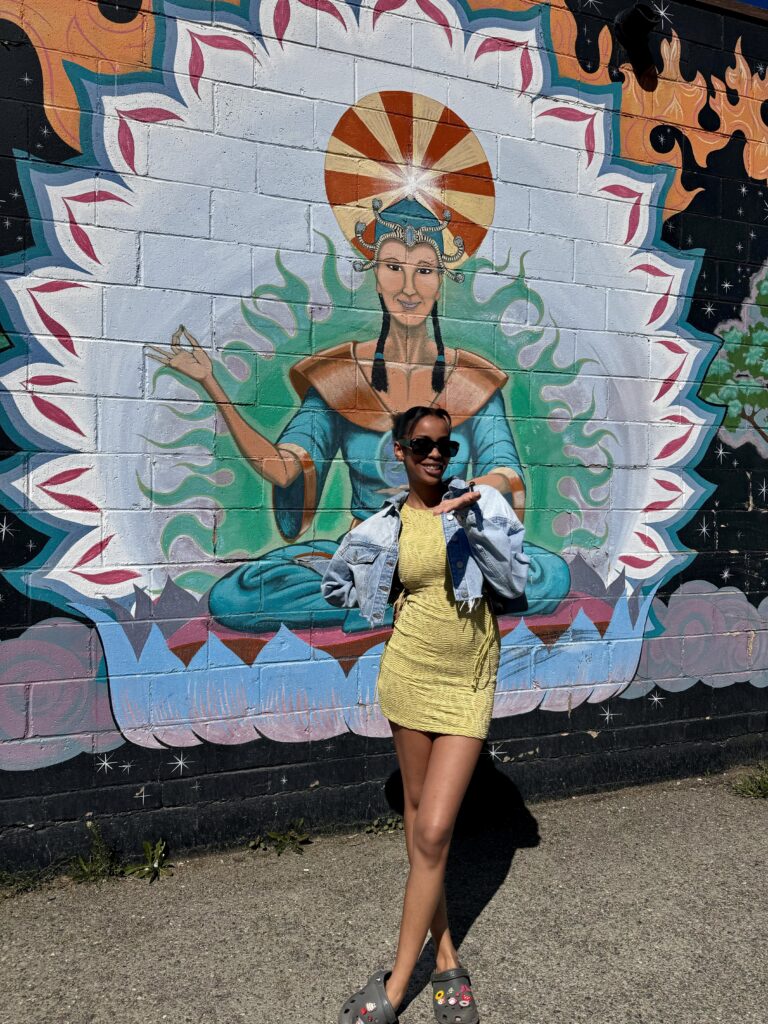Once neglected spaces in the heart of Kamloops are now spaces that bring a touch of colour to the area. The lively mural paintings that decorate Kamloops’ downtown transform the city’s alleyways into an outdoor art museum. With 33 stunning murals, the Back Alley Art Gallery transforms these spaces into a large museum, attracting both locals and visitors. Among the 33 paintings that make up the this stunning art gallery, several impressive artworks like The Jaguar Gate and Bee City stand out to many. Artworks like these not only attract people, but also tell important stories about Kamloops’ culture, creativity, and community.
The outdoor art gallery is more than a collection of murals. This project tells a story featuring art created by Indigenous artists, artworks honouring Italian heritage, and many other fascinating artistic displays of local history. These paintings were designed to show the city’s wide variety of culture while adding beauty to formerly abandoned spaces that were once unsafe. In addition to looking good, this public art project also acts as a way of communicating and educating both locals and tourists about the city’s history. By turning ordinary alleys and parks into artistic exhibitions, Kamloops has managed to redefine how people interact with public spaces and with each other, through the use of art.

The murals painted around Kamloops have brought about a noticeable change in public spaces around the city. Sarah Johnstone, a member of the McDonald Park Neighbourhood Association, describes how these paintings have brought colour and life to areas like McDonald Park. “The project was initiated to encourage more foot traffic, bring people here to enjoy local art, and ensure the park remains safe and secure for everyone,” she shared during an interview with CBC News. These uniquely beautiful artworks have been attracting and increasing the numbers of visitors, which has improved community involvement and pride for those living in these areas. Previously some of these areas were avoided by the community.
This project is part of the Kamloops Central Business Improvement Association’s Complete Streets program. This project is aimed at making urban spaces around Kamloops’ more “friendly, supportive, appealing, and safe,” according to their website. This project is similar to other urban revitalization projects across Canada. Cities such as Edmonton, Calgary, Winnipeg, and Toronto have also adopted this brilliant idea where murals not only beautify neglected spaces but also boost economic growth for businesses in the surrounding neighbourhoods, while also making sure that they creatively discourage vandalism.
These creative transformations have also had an impact on local businesses. These artworks have been able to bring real benefits to local businesses and neighbourhoods in the area. During an interview with Arjun, a waiter at Mucho Burrito in downtown Kamloops located at 531 Lansdowne Street, I got useful information on how the mural just a few meters from this restaurant has transformed their business. The business is located next to a famous mural known as Electric Alley painted behind the Delta Hotel. This hotel shares an alley with Mucho Burrito. When speaking to Arjun he mentioned, “We’ve noticed a significant increase in foot traffic. People stop to take photos, and many end up discovering our restaurant.” He recalled a memorable occasion with a couple visiting from Vancouver who stumbled across the mural and ended up having lunch at the restaurant. Arijun stated that they returned multiple times during their trip. “It’s like having free marketing,” he added, showing the unexpected economic boost brought about by the eye-catching artwork.
Nick, the Mustard Seed’s volunteer coordinator, also shared similar thoughts about the murals’ positive impact. Nick describes the alley behind the Blue Grotto as once being “dull and somewhat unsafe,” but now appearing bright and welcoming from his office. “It’s like having a front-row seat to an art gallery every day,” he said during our interview about the improvements around the downtown area. He has noticed how the murals have encouraged both locals and tourists to stop by and observe these paintings. He believes that this has added a sense of creativity to the area. Both Arjun and Nick believe that these murals offer more than just beautification. These pieces of art, they believe, will transform public spaces to make them safer and more profitable for everyone.
Besides serving as an art gallery, these paintings act as a means to showcase the voices of local artists. From Indigenous storytelling to Kamloops’ industrial roots, many murals represent themes related to the city’s identity. In the near future, the city plans to expand public art programs to reach new neighbourhoods and include more local artists. Art installations like the one taking place in the Lansdowne Street parkade show Kamloops’ determination to making art a key part of its identity.

Taking a walk through Kamloops’ colourful alleyways, you can hardly believe these spaces were once ignored and neglected. Today, they serve as living examples of how public art can transform a neighbourhood. The murals have contributed to the growth of local businesses as well as increasing community pride in the neighbourhood. Projects like the Back Alley Art Gallery are more than just beautiful additions; they are means of connecting people while sharing a story. As Kamloops continues to grow, these artworks represent the city’s commitment to inclusivity, creativity, and artistic expression. Rather than being just something to admire, art inspires change, builds connections, and brings communities together.
References
- Kamloops Central Business Improvement Association (KCBIA). “Back Alley Art Gallery initiative.” Retrieved from https://downtownkamloops.com.
- City of Kamloops. “Lansdowne Street parkade public art project.” Retrieved from https://www.kamloops.ca.
- De Mode Magazine. “The power of public murals: Transforming urban spaces through art.” Retrieved from https://www.demodemagazine.com.